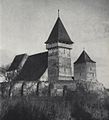Letter u
|
Brateiu Pretai Baráthely |
||||
|
||||
| Basic data | ||||
|---|---|---|---|---|
| State : |
|
|||
| Historical region : | Transylvania | |||
| Circle : | Sibiu | |||
| Coordinates : | 46 ° 10 ′ N , 24 ° 25 ′ E | |||
| Time zone : | EET ( UTC +2) | |||
| Height : | 319 m | |||
| Area : | 35.11 km² | |||
| Residents : | 3,415 (October 20, 2011) | |||
| Population density : | 97 inhabitants per km² | |||
| Postal code : | 557055 | |||
| Telephone code : | (+40) 02 69 | |||
| License plate : | SB | |||
| Structure and administration (as of 2016) | ||||
| Community type : | local community | |||
| Structure : | Brateiu, Buzd | |||
| Mayor : | Elena Marian ( PNL ) | |||
| Postal address : | Str. Principală, No. 513 loc. Brateiu, jud. Sibiu, RO-557055 |
|||
| Website : | ||||
Brateiu (also Bratei ; German Pretai , såksesch Pretoa , Hungarian Baráthely ) is a municipality in the Sibiu district in Transylvania , Romania .
location
Brateiu is located in the Kokeltal on the river Târnava Mare ( Great Kokel ), five kilometers from Mediaș ( Mediasch ) on the national road ( drum național ) DN 14 between Mediaș and Sighișoara ( Schäßburg ). The place in the narrower sense had 1956 inhabitants in 1992. The village of Buzd also belongs to the municipality of Brateiu .
history
The local area was already settled at the time of the Great Migration and during the Middle Ages. The region belonged to the Gepid Empire from the middle of the 5th century until the Avars took possession of the Carpathian Basin in 567. Excavations, which began in 1959 with a test excavation on the left bank of the Târnava Mare about one kilometer east of Brateiu, have shown three consecutive settlements and two burial grounds. The oldest settlement existed from the 4th to the first half of the 7th century, the second settlement from the end of the 7th century to the 8th century, and the third can be dated to the 12th century. Grave field no. 3 was occupied in the 6th and early 7th centuries and contained almost 300 body burials, with numerous grave goods, including pots, jugs and jugs, but also weapons. Compared to neighboring burial grounds , such as Band or Kölked -Feketekapu A, the pots are characterized by the fact that a large part of them was handmade. The dead are lying on their backs in a roughly west-east orientation.
The place was founded by German settlers and was first mentioned in 1283 as Mons Mariae (Marienberg), the local church was also dedicated to the Blessed Virgin Mary . The town experienced its heyday towards the end of the 18th century. After complaints to Emperor Joseph II about the bad condition of the fortified church, which was in danger of collapsing, were successful - it was built on marshy terrain - the community was expanded in the direction of Schäßburg, the natural river of the Kokel was diverted and the swamp surrounding the community was drained.
A long phase of emigration and decline began for the Transylvanian Saxons at the beginning of the 20th century. In 1903 there was a great wave of emigration to America . After the two world wars, the communist era and the last wave of emigration in 1990, only a few Saxons remained in Pretai. In 2002 there were still 32 German Protestant Christians living in the village.
Attractions
- The fortified church in Pretai: It is a late Gothic three-nave pillar basilica built in the 14th century. At the end of the 16th century a so-called wall chronicle was created on which biblical scenes are depicted. At the time of its creation it was considered the most extensive work of its kind in Transylvania. The altar also dates from the first quarter of the 16th century. The church was renovated between 1845 and 1846 and is now a listed building.
Web links
Individual evidence
- ↑ 2011 census in Romania at citypopulation.de
- ↑ Ligia Barzu, Radu Harhoiu: Gepidae as neighbors of the Lombards and the cemetery of Bratei. In: Jan Bemmann , Michael Schmauder (Ed.): Culture change in Central Europe. Lombards - Avars - Slavs (= colloquia on prehistory and early history. Vol. 11). Dr. Rudolf Habelt GmbH, Bonn 2008, ISBN 978-3-7749-3593-8 , pp. 513-578.
- ↑ List of historical monuments of the Romanian Ministry of Culture, updated 2010. (Romanian; PDF; 7.10 MB)






